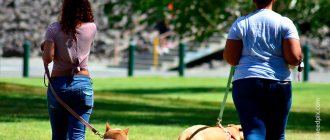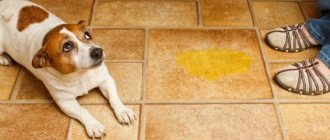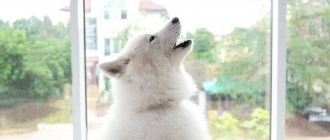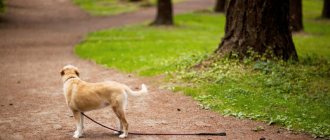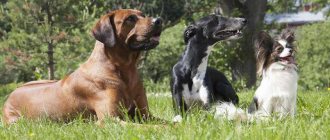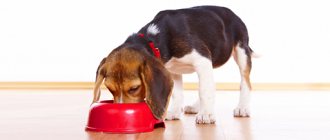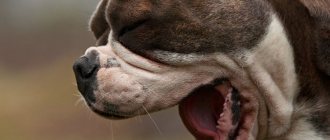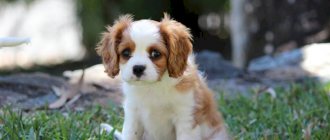Dog owners know firsthand what it means to train and train a pet. This requires a person to be patient, responsible and kind. It is a good attitude that determines the dog’s level of trust in you, as well as its ability to learn. Of course, it is worth considering that each animal has its own character. Its behavior is also determined by the breed to which the animal belongs. For example, service dogs have better developed endurance, although other species are not inferior to them in this quality. By this we want to say that inclinations need to be developed. It happens that you notice that as a result of regular training, your pet begins to show more discipline. Even if he is not a purebred breed.
The different ages of your pet are not a hindrance to training
You can toilet train your dog at any age. Most often you can find recommendations for training puppies. But people often get animals that are a year old or older. Such pets are found on the street, in special shelters, or given away by their former owners. The reasons may be different. It is important to understand that an adult dog requires a slightly different approach. Due to the fact that she has already lived through certain events, which, one way or another, were reflected in her character. In addition, some repeated events may have become habits. Therefore, correcting the behavior of an adult pet requires patience, understanding, and a caring attitude. A person’s already grown-up friend may not be accustomed to commands at all, or only know a few. But let's figure it out, is it possible to train an adult dog? The fact is that any training involves consolidating a skill. As with people, the younger the person, the easier it is to teach him. But even in middle age, a dog can be trained to ask to go outside to the toilet. In fact, sometimes people find it difficult with both a puppy and an adult animal. But imagine how a person would behave if his parents did not have the patience to explain to him how to eat or go to the toilet? Well, if the owner has finally started training, there is no need to retreat. But be careful with your persistence. An animal is also capable of understanding human feelings, being upset and being happy.
What causes constipation?
Constipation can be caused by many reasons. Some of them can be easily eliminated, for example, by changing the dog's diet - adding more fiber to it. However, constipation can also be a sign of a more serious problem, such as a tumor in the colon or rectum or an intestinal obstruction. Veterinarians can usually identify the problem based on where in the digestive tract it occurs.
Along with nutrition, the AKC identifies other common problems related to constipation in dogs:
- Aging.
- Activity level.
- Tumors in the gastrointestinal tract.
- Other tumors.
- Anal gland diseases.
- Prostate enlargement.
- Dehydration or electrolyte imbalance.
- Medications.
- Metabolic disorders.
- Diseases and injuries of the spine.
- Central nervous system disorders.
- Stress and psychological problems.
- Orthopedic diseases.
- Postoperative problems.
- Other disorders of the digestive tract, for example as a result of ingestion of foreign objects.
If your dog is constipated and it hasn't been long since his last bowel movement, there are some solutions you can try at home. For example, add wet dog food to your pet's diet. The high moisture content of this food can help move the intestinal contents forward. Exercising your dog more frequently can help, and you should also make sure he drinks enough water.
If constipation continues for more than a few days, consult your veterinarian to make sure it is not the result of a medical condition. Be sure to tell your veterinarian the last time your dog pooped, what the consistency of his stool was, what his diet was like, and any other signs of a problem. If you have an intestinal obstruction, a special procedure may be needed to clear the blockage.
How can you train an adult dog to go outside to go to the toilet?
We have talked about patience more than once. Just like with a small pet, an adult dog will require some work. To train your pet to ask to go outside, first take him out into the yard as soon as he wants to go to the toilet or starts doing it at home. It may be that even at night the dog needs to be taken outside. Don't scold, don't shout. This is only for the first time. Of course, you can say that this cannot be done. And immediately come up with a command that you can use when taking your dog to the toilet. For example, the question “Do you want to go for a walk?” And then try to take your pet out less often to relieve itself. A dog can tolerate 8 – 10 hours if it eats once a day. Sometimes even more. It is important, of course, to leave the diaper on and train the dog to use the litter box. Be calm about possible dog problems that can arise in animals as they age. We will tell you more about the teaching technique below.
We develop conditioned reflexes in a puppy to go to the toilet
We all remember Pavlov’s famous dogs, on which the scientist-physiologist proved the existence of unconditioned reflexes and the possibility of developing conditioned reflexes in animals. As in those experiments, the use of a bell here also brings sufficient results in an attempt to train a puppy to use the toilet on the street and, I must say, significantly speeds up and simplifies the learning process.
In this method, all similar actions described above are carried out, however, at the moment of “inviting” the puppy for a walk, when the owner approaches the door, in addition to pronouncing the key words, you should ring the bell. A loud metallic sound will always attract a dog much better than the owner’s usual voice, which makes the training process more successful. Over time, as the puppy acquires useful skills, the bell should gradually be abandoned, limiting itself to only key commands. However, it is worth noting that if a dog “tightly” gets used to listening to the sound of a bell, it can be extremely difficult to wean the animal off it; as a result, the dog will not move from its place without hearing the bell.
If our readers have questions or additions to the topic of how to teach a puppy to use the toilet on its face, you can leave your messages in the comments below.
Video tips from owners and experts:
What are the features of training an adult dog?
- Many dog breeders say that it is easier to train an older pet to ask to go outside. You may not have to cover everything with newspapers and diapers, set up an enclosure, or use other methods;
- Praise your pet if he did everything as needed. Give your dog a treat on the street and say “well done”;
- If your dog is stubborn, try to punish him gently. This does not mean that there should be no sternness in your tone. It is important not to get angry at the dog and not show it in your voice. To do this, it is worth understanding the reasons for the animal’s behavior;
- Some owners, for whatever reason, punish their pets by showing force. Don't do this as you may either intimidate the animal or provoke it into reacting. Sometimes even aggressively. In addition, it is important for a dog that the person nearby becomes a friend for it. Try to build relationships on trust;
- Increase the amount of time you spend walking. Play active games, run with the dog. But you need to walk until the dog does its job.
Dog training is a fun game!
Teach your furry friend to ask to go to the toilet and go outside without stress for both of you.
The course “Little Things to Do” is like an interesting quest, at the end of which the desired result awaits you.
Find out more
First aid
Such activities can only be carried out during 2, maximum, 3 days of absence of bowel movements. You can try oil, laxatives, petroleum jelly and other remedies yourself only if the dog does not experience any particular discomfort.
You can try an enema. Its use helps to soften stool that has dried out and stuck to the walls of the colon. An enema is the first thing to do and is used even before the decision is made to use laxatives such as Microlax.
Inside, the dog can be given castor oil or Vaseline, which are administered without a syringe or needle. The volume of the drug is calculated based on the size of the pet. If necessary, the dose can be divided into several servings, with an interval of no more than 30 minutes. Such a preventive measure can be carried out periodically for up to a month. But, if oil flows out of the anus unchanged, then you should urgently go to the veterinarian.
How to teach a puppy to ask when needed?
A small animal is not always able to understand what is good and what is bad. In training, it is very important to be able to correctly convey to the dog what they want from it. If you decide to get a puppy, determine what schedule the animal will live on. To do this, take into account not only the time you work and perform household duties. It is clear that the animal also has its own biological processes and needs. He needs to eat, sleep, walk and go when needed. You can influence this schedule later. But first, it is important to understand that a puppy goes to the toilet several times more often than an adult dog. Buy diapers and be as prepared as possible for the fact that the puppy can pee anywhere he walks. Please note that if your baby is 6-8 weeks old, he will go to the toilet every hour. At night, your new pet can do this once every 2-4 hours. Up to 16 weeks, the dog learns to tolerate 2 hours during the day and 4 at night.
When is this a problem?
First, determine if your dog actually has a problem. As a starting point, dogs typically walk once or twice a day.
The American Kennel Club (AKC) lists the signs of constipation in a dog. This:
- A break of several days between bowel movements.
- Pebble-like, hard, dry excrement.
- Tenesmus, which is when your dog strains with little or no effect. Or produces a small amount of liquid fecal matter with blood.
- Painful or difficult bowel movements, also known as dyschezia.
To train your puppy to use the litter box:
- The tray should be of medium size so that the pet begins to understand that this is a place for the toilet. We do not recommend buying large trays. The dog can lie down to sleep there, but it is inconvenient to turn around in a smaller tray;
- Learn to wait, because the puppy is still small and it may be difficult for him to learn right away;
- Watch the animal. Toilet times vary, but it is often important to focus on training after eating, sleeping, or playing;
- If you do not immediately change the rag or diaper in the tray, the puppy will quickly understand where he needs to go to the toilet;
- Place the tray where people are most often. For these purposes, a hall is suitable, in which you can install an enclosure with a tray and a place to sleep;
- At night and if you leave, be sure to leave your pet there. You can let him out during the day so he can be physically active. As soon as you notice that your pet begins to squirm or relieve himself, take him to the designated place. To do this, lightly tap and push towards the tray;
- If the puppy already enters the enclosure with a tray on his own, praise him;
- When you can't train your dog to use the toilet, use diapers to create a path to the litter box. You can also use a special spray.
Have you already tried it and it doesn’t help?
Enroll in an online school and solve your problem right now!
more details
You can train a puppy to ask to go outside from 2-2.5 months. It is at this point that the dog, as a rule, has already received all preventive vaccinations. Not being afraid to take your puppy outside will make it easier for you to start training. It is important to take a leash with you and never unfasten it if you are walking for the first time.
After the puppy has learned the routine, you can safely start taking him out for walks. It is advisable to do this after eating or sleeping. Also keep in mind that the older the dog, the less often he needs to go to the toilet.
Why does a dog pee and shit at home?
The little puppy you took into your apartment may not realize that you can’t shit in the house . During the first months of being at home, most puppies are quarantined due to vaccinations. Therefore, it becomes quite common for a small pet to relieve itself on the floor, where there is a special diaper or a piece of newspaper for it. When you start taking your puppy out, he can play happily and avoid going to the toilet.
It is important to remember that the urinary system in puppies is not yet sufficiently developed. A small pet cannot withstand 8-hour intervals between walks. Therefore, without waiting for the next walk, the puppy may shit on the floor.
Another reason may be lack of attention . It happens that you took your dog out for a walk in the morning and left him alone for the whole day. Wanting to express protest, the dog may, for no apparent reason, shit on the path. In this way, she expresses dissatisfaction with her owners, showing that she does not want to remain alone for a long time.
If an older dog in your home, who is regularly trained to go outside, suddenly begins to foul the house, pay attention to two possible reasons. Most likely, your pet is sick. Very often, dogs that eat dry food have problems with the urinary system. Also, your four-legged friend may have been frozen during his last walk.
If a dog not only pees at home, but also poops on the rug, this may be a sure sign of stress or resentment toward its owner. Do not ignore these reasons for your pet's disobedience.
How to train a dog to use a leash?
In order to go outside with your dog for the first time, it is important to know how to put on a collar correctly. If your pet is already 1-2 months old, you can train him quickly enough. Of course, any animal will be uncomfortable at first. To help your puppy adapt to the collar faster, put it on a few minutes before eating. Having fun while eating, the dog will experience less negative emotions. Choose a comfortable and soft accessory that does not restrict your pet’s movements.
When going outside, wear a collar. Let the dog run around the apartment a little and get used to it. Only then can you put on a leash. The dog may be confused at first. Walk around the house. If the puppy tries to chew on the leash, distract him with a treat.
